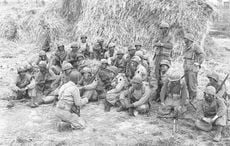June 22 was the exact date in 1850 on which 124 natives of Tracton, County Cork left their homes in a convoy - mothers, fathers, children, infants, grandparents.
Their destination was the Kinsale Workhouse, eight miles away. Their abject circumstances at the height of Ireland's Great Hunger compelled them to seek help at the gates of the Workhouse, though the building was grossly overcrowded with starving, sick and dying inmates.
Built to accommodate 500 normally and a stipulated maximum of 700 inmates, on July 28, 1849, the meticulously kept records show that there were 2,127 inmates on that day, that 90 had been admitted in that week and that 21 had died in the workhouse in the same week.
The most frequent descriptions used were “Mendicant” (describing a tramp or homeless person), “Beggar,” “Weak and Infirm,” “Idiot,” and “Weak-minded.” Many were described as “poorly clad” and “dirty.”
In their memory the people of Tracton hold an annual Famine Walk on a date near June 22. The same roads are travelled on foot, and every walker represents a named Workhouse/Famine victim.
The following are a few of their stories.
At the first signs of potato blight in the autumn of 1845, local relief committees were set up by the leading landowners and by the church ministers. After a hard winter, in January 1846 the board of the Kinsale Workhouse urgently petitioned the House of Lords for a “system of uniform eating for the maintenance of paupers.” All the signs of a looming catastrophe were now evident. Potato prices had gone through the roof and the workhouse managers decided to drop potatoes from the diet of the inmates.
The workhouse was well known to Tracton people by that date; every day since the failure of the main food source, the Lumper potato in the autumn of 1845, a constant stream of destitute and starving people trekked in desperation to the gates of the Kinsale Workhouse.
The meticulous records kept by the personnel of the workhouse, which are available to be studied at the Cork County and City Archives, mean that we can identify every man, woman and child who was admitted to the workhouse, those who died in the workhouse or who died outside the gates waiting for admission, and those who survived and made it home again.
For example, on February 4, 1847, 40 persons were admitted to the Workhouse, ages ranging from a baby of four months to a man of 60 years. Eleven of those admitted were children. Among those admitted on that day was Mary Dineen of Kilpatrick and her five children, aged from five to 16 years. Mary died on the day she was admitted, leaving her five orphans to the mercy of the Kinsale Workhouse. Cornelius Desmond,Tracton, aged 17, died on the day he was admitted in May of 1847.
An entry made on June 22nd in 1850 shows that four sibling orphans, Mary, Kate, John and Norah (aged two) Neil (Neill) were all admitted to the workhouse on that day.
After being registered, washed, deloused and inspected, John was sent to the boys’ quarters and the three girls, Norah in her ‘big’ sister’s arms, were directed to the girls’ quarters.
During their time in the workhouse this strict segregation continued. Wives and husbands were separated, children were separated from their parents, brothers from sisters. That was the official policy.
We do not know if any of the Neil children survived the diseases rampant in the workhouse. The two older girls may have been shipped out to Australia as part of the solution by the Board of Guardians to deal with the large number of orphaned teen aged children left bereft in workhouses during Ireland’s Great Famine (1847- 1850).
The orphans were of a party of 124 men, women and children, old and young, who left their homes in the Tracton area in South Cork on that day in June 1850 to walk the eight miles to the Kinsale Workhouse.
Another famine-stricken family was that of Cornelius Coffee/Cowhig, his wife, Mary and their five children, who were signed in on December 13, 1848.
The awful truth about the chances of surviving the rampant diseases in the workhouse is brutally exemplified by the fact that when Cornelius and his family were discharged in May 1849, only two of their five children were left alive to return home with their parents.The bodies of those who died in this workhouse lie in the Famine Graveyard just 100 yards from the main gates.
The voice of Fr. Cornelius Corcoran, the Parish Priest of Tracton, was loud in publicizing the crisis in his parish, (and, by extension, of other parishes) as he issued statement after statement from Ballyfeard House. Most appeared in the London and local newspapers, such as this one on February 1947:
“This large sea-coast territory which stretches from Cork’s Harbour mouth to that of Kinsale, is steeped in affliction. It witnessed this week the most appalling miseries that a civilised country could present, or a savage tribe endure - auctions, evictions, famine, fever houses tumbling, manhood weeping, hearts breaking, emigrants adieu, the mourners’ wailing, the bailiff’s triumph- the curse that requited it. I witnessed despair in every face and desolation on every hearth. Distress in the same terrific reality pervades all the coterminous parishes as you pass from here to Donegal via Skibbereen and Kilrush.
The published letter of, Rev J.Cecil Rogers, Rector of the Church of Ireland in Nohoval, should also give us pause for thought. Rev Roger’s letter was published in the Evening Standard in February 1847. In it he wrote, “We are accused of exaggerating our distress and painting it in darker colours than truth will warrant, in order to obtain more liberal supplies from the wealthy English. Oh, I so wish that they who so accuse us were but one hour in my parish. I could show them such scenes of misery as would thrill their blood.I could show them living skeletons crouching and trembling together in one corner of their dark and cheerless chambers while at the other lies the corpse of a father or a brother dead from the effects of hunger…”
It is incredible to us in today’s world that while the Parish Priest of Tracton, Canon Cornelius Corcoran, and the Rector of the Church of Ireland in Nohoval, Cecil Rogers, were literally carrying emaciated bodies on their backs to the churchyards for burial that a grand ball in Cork City was graced by wealthy young women of Tracton, near neighbours of those emaciated bodies, whose only worry for the night was that their gowns would be as rich as the next one. However, let it be also told that the local landlords, the fathers of those fashion-conscious ladies, did their best to help their starving tenants; several of them served on the Governing Body of the Kinsale Workhouse, and one Famine victim was Lady Roberts of Roberts Cove, who died when she contracted a fever as she administered to the sick.
The Tracton famine victims will be well remembered by those who walk in their names. Funds raised are donated to the local Community Centre and to the Kinsale Community Hospital.
At the conclusion of the Famine Walk of 2012, a hawthorn tree was planted to commemorate the Tracton Famine victims admitted to the Kinsale Workhouse during the years of the Great Famine. The tree is thriving.
For more information see the Facebook pages of Tracton Famine Walk, or Tracton Family History, or, Tracton Arts and Community Centre, or call the Tracton Centre at 011-353-86-0711910.




Comments